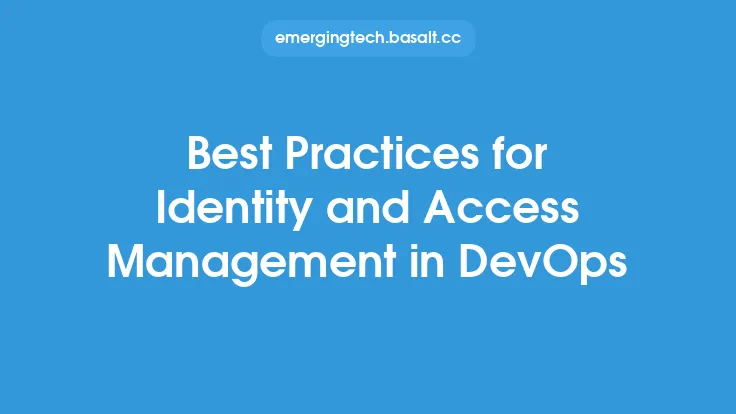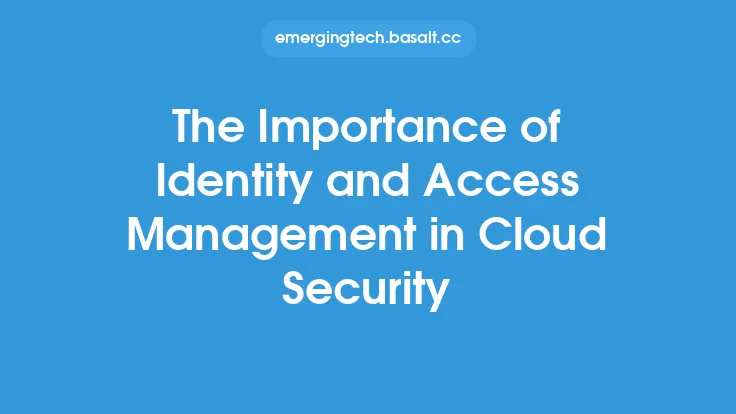The increasing number of IoT devices connected to the internet has created a vast attack surface, making it challenging for organizations to manage and secure these devices. Identity and Access Management (IAM) for IoT devices is a critical aspect of cybersecurity that involves managing the identities of devices, users, and applications, as well as controlling access to resources and data. In this article, we will delve into the challenges and solutions of IAM for IoT devices, exploring the technical aspects and best practices for securing these devices.
Introduction to IoT Device Security
IoT devices are inherently insecure due to their limited computational resources, lack of standardization, and the need for ease of use. These devices often have weak passwords, outdated software, and poor encryption, making them vulnerable to attacks. Moreover, the sheer number of IoT devices connected to the internet makes it difficult for organizations to keep track of each device, its location, and its access privileges. As a result, IAM for IoT devices is crucial to prevent unauthorized access, data breaches, and other security threats.
Challenges in IAM for IoT Devices
There are several challenges associated with IAM for IoT devices, including:
- Device Heterogeneity: IoT devices come in various shapes, sizes, and operating systems, making it challenging to develop a standardized IAM solution.
- Scalability: The large number of IoT devices connected to the internet requires IAM solutions to be highly scalable and able to handle a vast number of devices.
- Limited Resources: IoT devices often have limited computational resources, making it difficult to implement robust security measures.
- Lack of Standardization: The lack of standardization in IoT devices and protocols makes it challenging to develop interoperable IAM solutions.
- Security Threats: IoT devices are vulnerable to various security threats, including malware, DDoS attacks, and data breaches.
Solutions for IAM in IoT Devices
To address the challenges associated with IAM for IoT devices, several solutions can be implemented, including:
- Device Profiling: Creating profiles for each IoT device to track its identity, location, and access privileges.
- Unique Identifiers: Assigning unique identifiers to each IoT device to prevent spoofing and ensure secure communication.
- Secure Communication Protocols: Implementing secure communication protocols, such as TLS and DTLS, to encrypt data transmitted between IoT devices and the cloud or other devices.
- Access Control: Implementing role-based access control (RBAC) and attribute-based access control (ABAC) to restrict access to resources and data based on device identity, location, and other attributes.
- Authentication and Authorization: Implementing robust authentication and authorization mechanisms, such as public key infrastructure (PKI) and OAuth, to ensure secure access to resources and data.
Technical Aspects of IAM for IoT Devices
From a technical perspective, IAM for IoT devices involves several key components, including:
- Device Management: Managing the lifecycle of IoT devices, including provisioning, configuration, and decommissioning.
- Identity Management: Managing the identities of IoT devices, including device registration, authentication, and authorization.
- Access Control: Controlling access to resources and data based on device identity, location, and other attributes.
- Encryption: Encrypting data transmitted between IoT devices and the cloud or other devices to prevent eavesdropping and tampering.
- Key Management: Managing cryptographic keys used for encryption and authentication to ensure secure communication.
Best Practices for IAM in IoT Devices
To ensure secure IAM for IoT devices, several best practices can be followed, including:
- Implementing Secure Communication Protocols: Implementing secure communication protocols, such as TLS and DTLS, to encrypt data transmitted between IoT devices and the cloud or other devices.
- Using Unique Identifiers: Assigning unique identifiers to each IoT device to prevent spoofing and ensure secure communication.
- Implementing Role-Based Access Control: Implementing RBAC and ABAC to restrict access to resources and data based on device identity, location, and other attributes.
- Regularly Updating Software and Firmware: Regularly updating software and firmware to ensure that IoT devices have the latest security patches and features.
- Monitoring and Analyzing Device Behavior: Monitoring and analyzing device behavior to detect and respond to security threats in real-time.
Conclusion
In conclusion, IAM for IoT devices is a critical aspect of cybersecurity that involves managing the identities of devices, users, and applications, as well as controlling access to resources and data. The challenges associated with IAM for IoT devices, including device heterogeneity, scalability, limited resources, lack of standardization, and security threats, can be addressed by implementing solutions such as device profiling, unique identifiers, secure communication protocols, access control, and authentication and authorization. By following best practices, such as implementing secure communication protocols, using unique identifiers, and regularly updating software and firmware, organizations can ensure secure IAM for IoT devices and prevent security threats. As the number of IoT devices connected to the internet continues to grow, the importance of IAM for IoT devices will only continue to increase, making it essential for organizations to prioritize the security and management of these devices.





